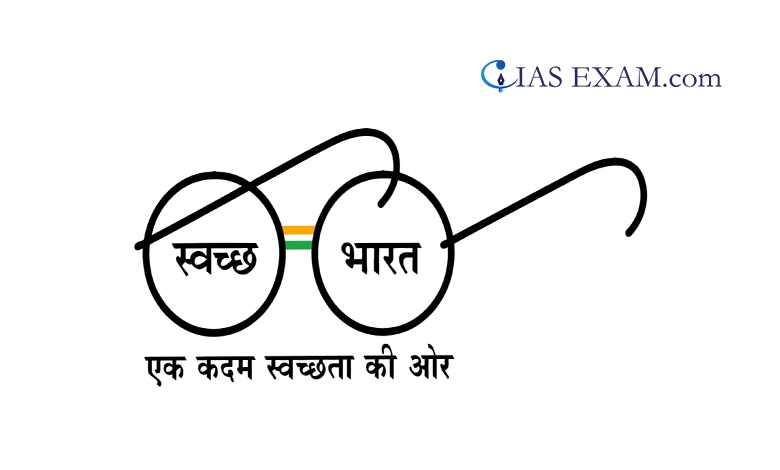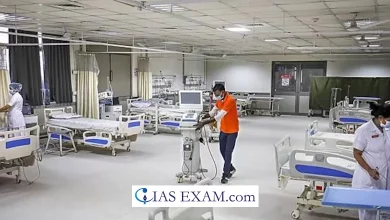Reality and Impact of the Swachh Bharat Mission
GS Paper 2 - Governance, Transparency and Accountability

Context
India was ranked right at the bottom of 180 countries in the Environment Performance Index (EPI) in 2022. The EPI ranks countries on climate change performance, environmental health, and ecosystem vitality. The Government has embarked on several campaigns of environmental health and development in the past 10 years including the Swachh Bharat Mission (SBM), the Atal Mission for Rejuvenation and Urban Transformation, the Pradhan Mantri Awas Yojana, and the National Clean Air Programme. The SBM is meant to address the issue of WASH (Water, Sanitation, and Health). However, what is witnessed is an increase in the vulnerability of the population owing to air and water pollution, among others.
About Swachh Bharat Mission (SBM)
- It is also known as the Clean India Mission, is a significant campaign initiated by the Government of India on October 2, 2014 and is primarily aimed at eliminating open defecation, improving solid waste management, and promoting cleanliness across the country.
- It is a massive mass movement that seeks to create a Clean India by 2019. The mission will cover all rural and urban areas where the urban component of the mission is implemented by the Ministry of Housing and Urban Affairs, and the rural component by the Ministry of Jal Shakti.
- The Mission was initially divided into two phases:
-
- Phase 1 – The programme includes elimination of open defecation, conversion of unsanitary toilets to pour flush toilets, eradication of manual scavenging, municipal solid waste management and bringing about a behavioral change in people regarding healthy sanitation practices. The mission aims to cover 1.04 crore households, provide 2.5 lakh community toilets, 2.6 lakh public toilets, and a solid waste management facility in each town.
- Phase 2 – SBM-U 2.0 envisions to make all cities ‘Garbage Free’ and ensure grey and black water management in all cities other than those covered under AMRUT, make all urban local bodies as ODF+ and those with a population of less than 1 lakh as ODF++, thereby achieving the vision of safe sanitation in urban areas.The Mission will focus on source segregation of solid waste, utilizing the principles of 3Rs (reduce, reuse, recycle), scientific processing of all types of municipal solid waste and remediation of legacy dumpsites for effective solid waste management.
Different Components of SBM
- Swachh Vidyalaya Abhiyan – The Ministry of Education has launched the Swachh Vidyalaya Programme under SBM with an objective to provide separate toilets for boys and girls in all government schools within one year.
Rashtriya Swachhta Kosh – It has been set up to facilitate and channelize individual philanthropic contributions and Corporate Social Responsibility (CSR) funds to achieve the objective of Clean India (Swachh Bharat).- GOBAR – DHAN – Galvanizing Organic Bio-Agro Resources Scheme (GOBAR-DHAN) scheme was launched by the Ministry of Jal Shakti in 2018 and aims to augment income of farmers by converting biodegradable waste into compressed biogas (CBG).
Challenges with SBM
- Poor Quality of Infrastructure: Reports suggest inadequate construction quality of toilets under the Swachh Bharat Mission (SBM), raising questions about the effectiveness of the initiative.
- Inadequate Access to Sanitation Facilities: Despite government claims, communities in slums and peri-urban areas still lack access to public toilets, contributing to sanitation challenges.
- Lack of Waste Treatment: Toilet construction in rural areas is not linked to waste treatment, leading to improper disposal of faecal sludge and environmental contamination.
- Ineffective Waste Management Technologies: Large, capital-intensive waste management technologies have failed to meet expectations, resulting in health crises and the need for additional resources to fix them.
- Privatization of Public Health Services: The outsourcing of sanitation work to private contractors, often employing subjugated communities, has led to the privatization of public health services and perpetuated caste discrimination.
Measures to be Adopted to Address the Issues
- Focusing on Vulnerable Section – While India has made significant progress in sanitation coverage, some individuals, households, and communities in disadvantaged sections of society, such as female-headed households, landless people, migrant laborers, and disabled people, still lack toilets or find existing toilets inaccessible.
- Integration with Public Health Infra – Sanitation practices in educational institutions, childcare centers, hospitals, and other government facilities need to be further improved. Sanitation coverage of disaggregated data in public facilities and across government departments requires innovation to make it a long-term and viable choice, which will be critical in public health infrastructure.
- Improving Sewer Infra in Villages – The lack of functional sewage infrastructure posed a significant obstacle to the successful implementation of the Swachh Bharat Abhiyan at the Gramin scale. As the people went out to defecate, areas lacked a functioning sewage infrastructure to handle the waste that was generated.
- Waste Management Systems – To achieve 100% solid waste management in the country, the ministry should take steps to scale up waste processing in all lagging states, with a focus on segregation at the source, primary collection, secondary storage, transportation, secondary segregation, resource recovery, processing, treatment, and final disposal.
Conclusion
India has surely achieved tremendous progress on SDG 6 by improving universal toilet availability through SBM. At the same time, India must evaluate its effectiveness in terms of environmental safety and fecal-oral transmission of illness, which aids children in spending their infancy free of malnutrition or early mortality. By doing so, and by reacting to the complexity of SBM outlined, India and other nations will be shown avenues to fulfilling sanitation agendas, attaining universal sanitation for all, and meeting SDG targets and objectives.
SOURCE: The Hindu





.png)



